|
Posted: 11/5/2018 5:32:26 PM EDT
[Last Edit: BigJimFish]
Sightron SIIISS624x50LRFFP/MH sub $1k ffp long range scope review by BigJimFish
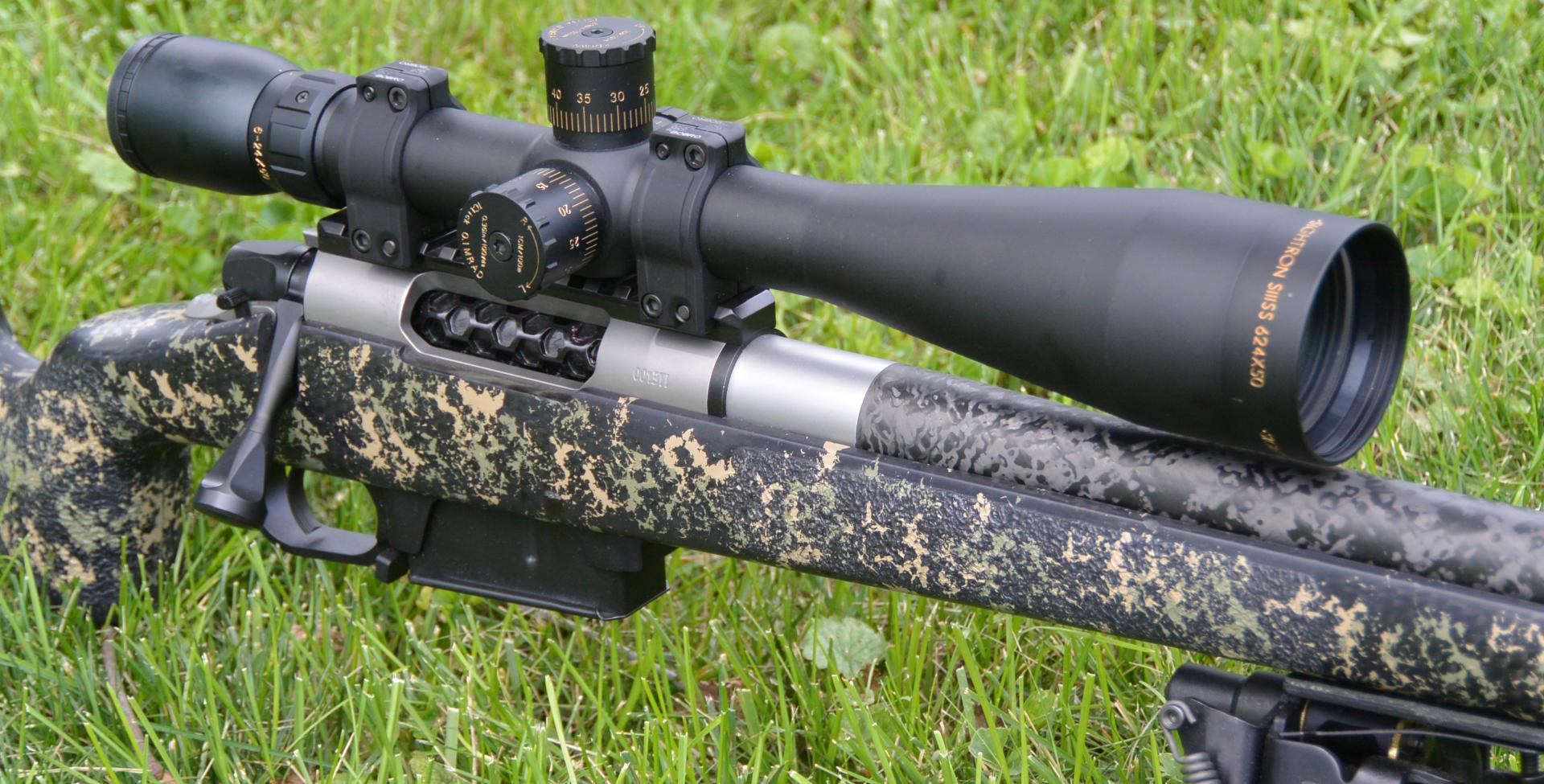
Sightron SIIISS624x50LRFFP/MH on a Mesa Precision arms Crux with Bobro LabX rings 
Les (Jim) Fischer BigJimFish Written: Sept 9, 2018 Table of Contents: - Background - Unboxing and Physical Description - Reticle - Comparative Optical Evaluation - Mechanical Testing and Turret Discussion: - Summary and Conclusion - Upcoming Models and Changes - Testing Methodology: Adjustments, Reticle Size, Reticle Cant - Testing Methodology: Comparative Optical Evaluation Background: Sightron is best known in the target shooting community for producing solid no frills scopes at prices lower than comparable competitors. Sightron has always appeared to be low on advertising expenditures and behind the curve on features, but their quality, price, and customer service has been good. A few years ago I spent a long time at the Sightron booth talking to one of their reps about the features necessary for precision rifle shooting, price points, where I saw gaps in the market, and why none of their current products did what I wanted them to do. It felt like a productive conversation. I found out some useful information about what they thought it would cost them to do this or that and I hope they found it useful as well. I remember specifically focusing on mid range FFP mil/mil stuff around $1k and low cost 2FP mil/mil stuff. They have since added the mid range FFP mil/mil scope in this review, a higher cost FFP mil/mil ED offering, and will soon be doing some lower cost FFP mil/mil stuff as well. Maybe I even had something to do with this. Either way, they now have some offerings that I find interesting. Unboxing and Physical Description: The Sightron SIIISS624x50LRFFP/MH is a little surprising when it comes to the extras in the box. Instead of the near ubiquitous plastic scope caps, it includes a sunshade, scopecote, and lens cloth. It is both different than what I expected and also a bit more. As far as documentation goes, the SIII includes a manual that appears to be generic to all Sightron scopes and an insert specific to this model which has a dimensioned diagram of the reticle and some mil equations. I was able to give myself a nice big pat on the back for thoroughness by finding the mil equations in the insert and one of the tables in the booklet to be in error. I'll bet it was a fun time in the office when that memo came rolling through. I suspect I was the only party involved who enjoyed himself. A party of one is still a party though, right? In any case, the equation in the insert is fixed now and hopefully the table in the manual is being updated as well. The scope itself looks and feels very clean. It is a Japanese produced product and has the top shelf fit and finish you generally see in products coming out of Japan. The knobs are just 5 mils per turn instead of the more common 10 mils, but feel very good. They are neither squishy nor those ones that are so stiff its difficult to click just one increment . Similarly, the stiffness on the parallax and fast focus eye piece are also quite pleasing. The styling is sort of hunter with just a slight nod to tactical in the knurled and uncapped adjustments. The optic is relatively long at 14.96", narrow with a 50mm objective, and light at 23.8 oz. These factors, along with the 4x erector ratio and the simple objective lens group I have observed indicate a pretty conservative optical design. This is not surprising given how economical this optic is relative to others with similar optical and production quality. It should also work out very well when it comes to the optical performance later on in the testing. In keeping with the simple theme, the model is un-illuminated and has no zero stop or lock on the adjustments, though the zero can be reset. The markings on the knobs must have been something of a debate within Sightron because, in addition the included knobs, there are a few you can buy aftermarket with better markings. The included knobs are marked in a not so contrasty gold script every 5 clicks with, unaccountably, the number of clicks rather than any actual angular dimension. You can partially remedy this with a gold sharpie by adding a decimal point to make the clicks mils instead. The properly done what they call “tactical knobs” use a higher visibility white script and are labeled in mils every .5 mils. The elevation on those knobs also has additional lines for other turns and the windage is marked to 2.5 mils R or L. I believe this scope will fit the 74007 knob that has markings up to 15 mils as well as the listed 74006 one which has markings only to 10 mils. With a 20MOA base, this scope may actually have slightly more than 15mil of travel depending on your rifle's zero. Evidently, the argument about which knobs to include in the box was won by someone who has never shot at distances requiring significant drop compensation - perhaps it was our trigonomically challenged manual writer. Either way, the properly marked knobs are $50 each so... probably sharpie. 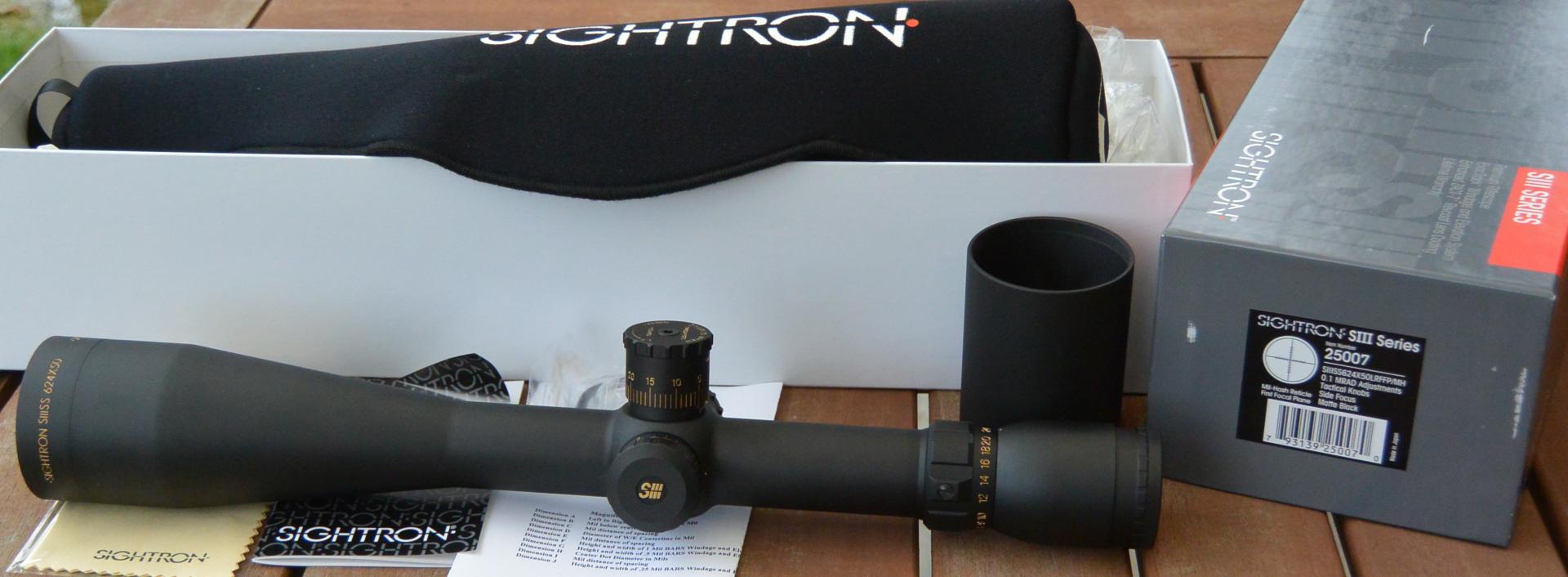
Sightron SIIISS624x50LRFFP/MH Unboxing Reticle: There are not a lot of options in general around Sightron's SIII front focal plane line. Actually, there are exactly two, mil or MOA. Both the mil and MOA versions have a reticle matched to their adjustments and only that one reticle. In both cases these reticles are quite simple. The mil version has no labels, but features markings at 1 mil and .5 mil increments with .25 mil markings for the first mil and the target dot type floating center that seems to be the current trend for whatever reason. The reticle is itself on the fine side of spectrum in terms line thickness. I am, and have always been, in favor of fine reticles. I have found them to be more precise, a bit faster, and far more comfortable. Thick caterpillar reticles always give me the same feeling as a gnat flying around my head. I just want to swat them out of my view. Overall, there is really nothing special about the SIII's mil reticle but also nothing particularly problematic. It is really a pretty good design for broad appeal. I don't think anybody will hate it, but it is also not going to be anybody's favorite and that is pretty much how I feel about it as well. In testing, the reticle showed no deviation in size from the correct dimensions and also showed no can't relative to the adjustments. So spot on with that. 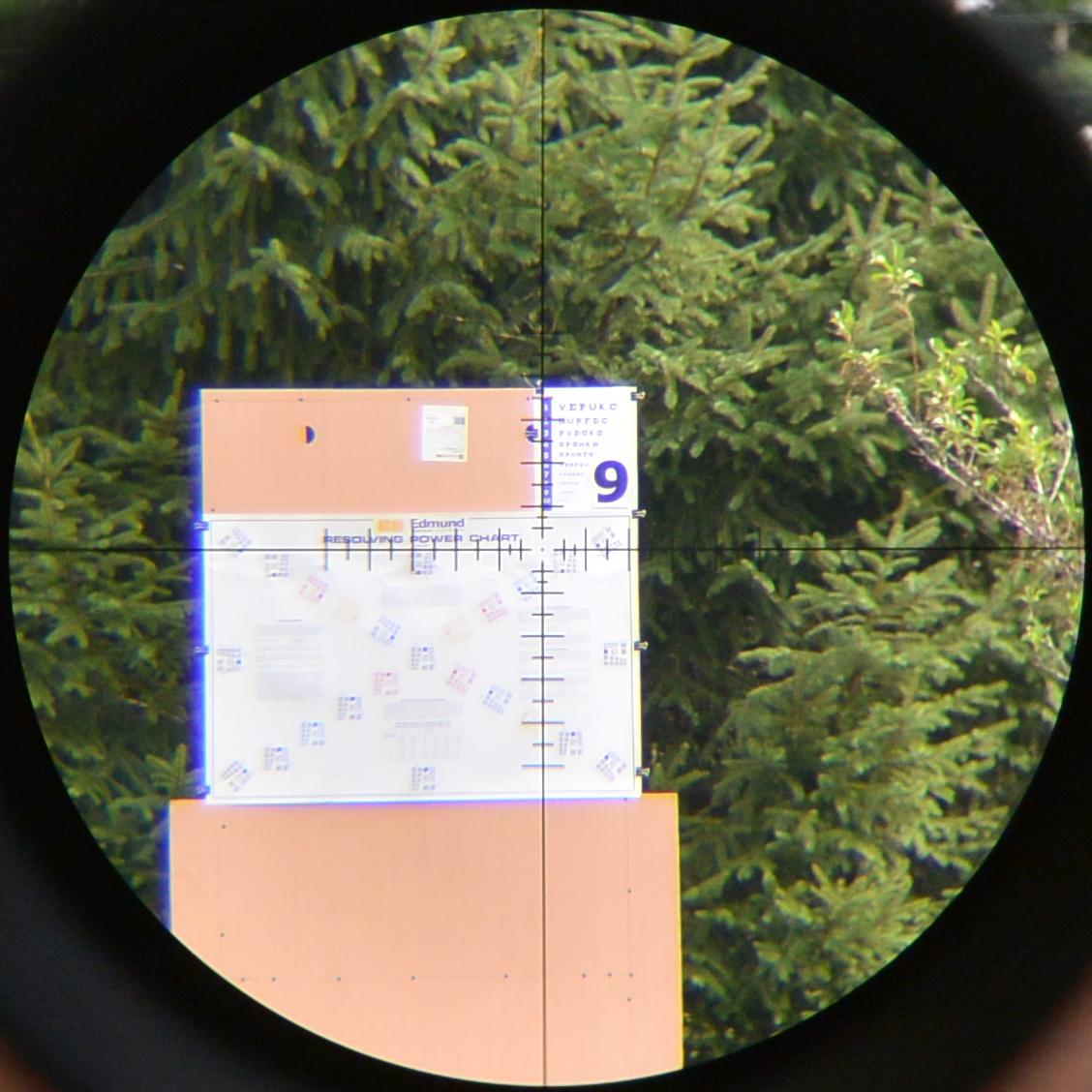
Sightron SIIISS624x50LRFFP/MH reticle on an optical test pattern Comparative Optical Evaluation: The Sightron SIII arrived earlier this year than any of the other test scopes and coincided perfectly with the first of the two review rifles for the year, the Kelbly Atlas Tactical and Mesa Precision Arms Crux. The timing was quite fortuitous as the SIII has a higher magnification than any of my personal scopes and also has a nice fine reticle. These two characteristics are of great importance for accuracy testing rifles. This gave me a great opportunity to have a lot of time behind the optic before any of the systematic optical and mechanical testing. I was quite pleased with the SIII's performance during this rifle testing. In particular, it struck me as very good optically, resolving impacts with such alacrity that my estimations of group sizes while firing strings proved to be spot on. For optical comparisons to this Sightron SIII, I had the other scopes in this series of sub $1k FFP mil/mil precision rifle scope review, the Athlon Midas TAC 6-24x50 mm, and Athlon Ares BTR 4.5-27x50 FFP IR Mil, as well as two that have been used as comparisons by me in previous reviews for context, the Leupold Mk 6 3-18x44 and my old (and now discontinued) Zeiss conquest 4.5-14x44. All of these scopes were lined up together on a 5 slot adjustable v-block and evaluated using the procedure outlined in the methodology section at the end of this review. This same methodology is used on all long range scope evaluations and has been for several years now. I have never before had a set of 5 scopes with such generally close optical performance. Usually, scopes somewhat sort themselves into performance tiers with higher tier scopes being better than lower tier scopes in pretty much all characteristics. That was not even remotely the case with this lineup. No scope was always first or last when evaluating particular performance parameters and the order of the scopes rankings changed with pretty much every particular parameter being evaluated. That being said, the Sightron SIII was, on balance, the best. It particularly excelled when it came to resolution, contrast, stray light handling, low light performance, and, unsurprisingly given its conservative design, depth of field. With regard to the eyebox, it was more middle of the pack, though it did not feel tight, cramped, or finicky, but rather seemed large enough. Similarly, it was close to average in chromatic aberration, though the field all performed well in this regard. The only parameter where the SIII's performance was sub-average for the group was in field of view. I did not notice any particular favor given to this or that end of the spectrum by the SIII such as is the way some scopes tend to favor greens or reds. Instead, the SIII seemed pretty balanced. To some extent, I expected the SIII to have the best overall optical performance. It fits with the narrative of few features and high quality that I was expecting by reputation. To me, the SIII is what you get when you set out to see just how low cost you can make something of a high standard and still have what you need to shoot long range. You use a simple optical design and turrets, drop some features like illumination, and streamline the distribution by removing virtually all the options, variations, and most of the marketing budget. What you would expect would be excellent performance for the price and that is what the SIII delivers optically. Mechanical Testing and Turret Discussion: As mentioned in the unboxing section, the SIII features simple 5 mil per turn adjustment knobs with no zero stop or turn indicator and a less than ideal marking scheme, but with great feel. The zero setting on these knobs is done with a single torx screw on top. Testing the accuracy of these adjustments was done in accordance with the methodology section detailed at the end of this review. This methodology was followed on all the scopes this year and has been in use for a few years now. In testing, the adjustments deviated in the following ways and degrees: Adjusting impact up from optical center, they were accurate to 4.0 mils. At 5.0 mils on target the adjustments read 4.9 mils. At 7.0 mils on target the adjustments read 6.8 mils. At 10.0 mils on target the adjustments read 9.7 mils. The scope adjusts up to 12.7 mils on the target, at which point the adjustments are at 12.4 mils. There was no continued movement of the adjustments after travel movement of the reticle stopped. Adjusting down from center the scope was accurate to 2 mils. At 3 mils on the target the adjustments read 2.9 mils. At 7.0 mils on target the adjustments read 6.8 mils. At 10.0 mils on target the adjustments read 9.7 mils. At 14.0 mils on target the adjustments read 13.6 mils. The scope adjusts down to 15.0 mils on the target at which point the adjustments are at 14.7 mils. There was no continued movement of the adjustments after travel movement of the reticle stopped. The windage varied similarly to elevation measuring 4.0 mils on the target at 3.9 mils on the adjustments each way. This tracking was repeatable and it returned to zero with no problems. Tracking on windage and elevation was properly independent. No zero shift was affected by power change, parallax change, or diopter change. For those wondering, it is not unusual to have more adjustment on one side of optical center than on the other. Though the tube will have the same amount of room on both sides of center, other factors, such as the return spring or turret housing, often limit travel in one or the other direction. Getting adjustments to exactly match the correct magnitude is one of the most difficult aspects of scope manufacture. As such, most scopes show deviation to some degree measurable with my equipment. The average deviation, based on my past tests, is about 1% at 10 mils. The SIII was a good bit above this, deviating 3% at 10 mils. The effect of this on the shooter is that you need to correct your estimated Ballistic table for it. If you print tables from online calculators, such as I do, you can tailor each entry to reflect the scopes exact deviation at that point. In the case of smartphone type ballistic computing applications, some now include an input to allow for deviations, usually linear, arising from the scope. Most of the time scopes do not deviate entirely linearly, however. Scopes usually deviate by more the further from center the adjustment moves, as is the case with this one. In the end, most app-based ballistic calculators often struggle both with this correction as well as with integrating actual data proven in the field with the calculator’s estimations. At some point I should probably do a whole review set on ballistic calculators, but that is not today's project. The takeaway from the mechanical testing is that the SIII tracks cleanly and repeatably, but has a bit more deviation than I would expect. This will mean more correction to ballistic tables than is typical. It should also be mentioned that each SIII example should not be expected to vary by the same amount with regard to the magnitude of the deviation in the adjustments and all scopes are like this. All scopes are typically designed to have no deviation but slight lens positioning differences from piece to piece result in deviation from the design specs. 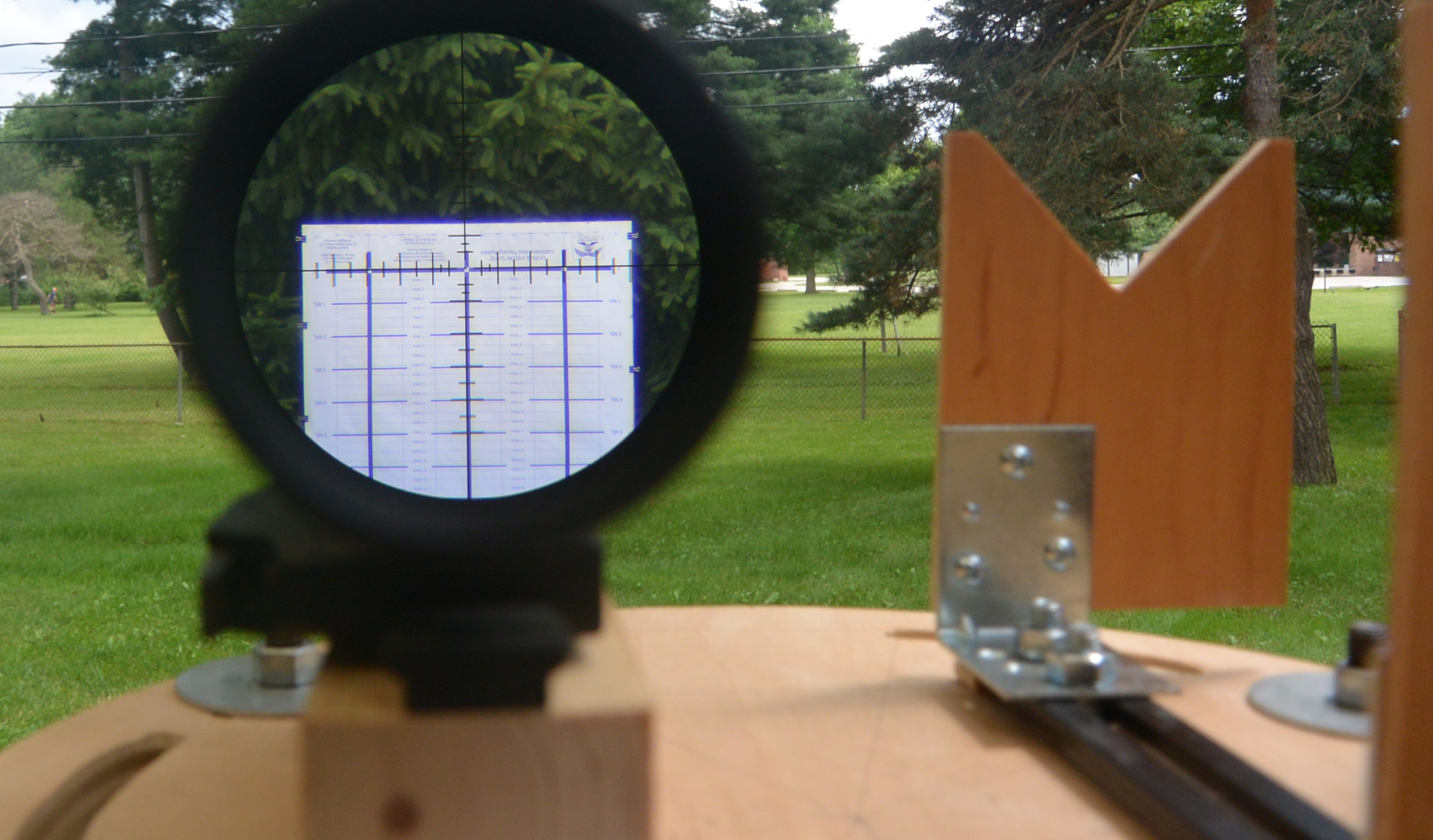
Sightron SIIISS624x50LRFFP/MH during mechanical testing Summary and Conclusion: Quite frankly, this year’s set of sub $1k ffp mil/mil precision optics has proven much better than I expected. A few years ago you really couldn't get the features necessary to shoot long range in an optic for under $1.2k and I really didn't like any of the options until almost $2k. I like this Sightron though and I like some of the other sub $1k options as well. Shooters now have some real viable and meaningful choices in long range precision optics for a budget. As for that budget, the street price on this Sightron varies significantly from outlet to outlet, but the shooter should find it for well below $1k. I think the SIIISS624x50LRFFP/MH represents a low featured but well manufactured precision rifle scope. It is the best optically that I have tested and is significantly better than I would expect from a scope at that price. Similarly, I expect it too be pretty durable as the production line it comes from has a long history of durability and longevity. Sightron also has a good reputation for backing their products should anything go amiss. The SIII's features are limited, though, and the adjustments are neither 10 mils per turn nor very well marked unless you spend the $50 for the aftermarket turrets. It is also not illuminated. Lastly, the 3% deviation in adjustments at 10 mils from the example I have would suggest that one element of keeping costs low is the allowance of wider tolerances in manufacture than average, specifically in the manual labor of lens positioning that accounts for a large amount of manufacturing cost. This does mean more correction of data by the end user. All told, I am certain that the package Sightron has put together here will be found compelling by many and develop a significant following. I know I am quite taken with it. Here is Your Pro and Con Breakdown: Pros: Exceptional optics for the cost in almost every aspect Lightweight Nice extras with sunshade and scopecote Good adjustment range All the knobs feel good (sorry, pun not avoided) Reticle is acceptable and sized properly Tracks repeatably with no zero shifts Good warranty and reputation Cons: Stripped features, 5mil/turn, no illumination, no turn indicator, low erector ratio Poorly labeled adjustments unless you buy aftermarket The tested example had more deviation than average on adjustments Manual is lacking and contains basic errors 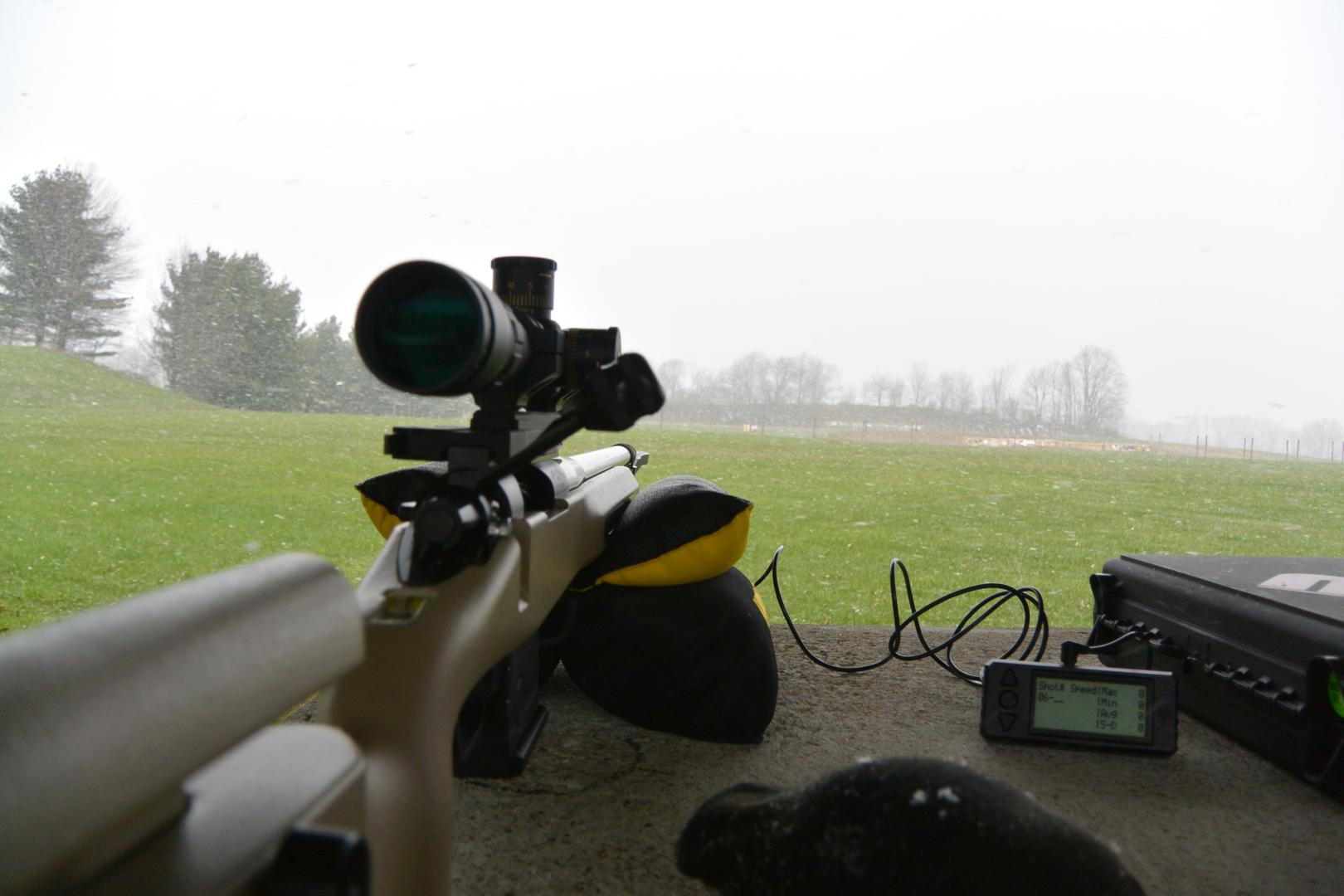
Sightron SIIISS624x50LRFFP/MH in Bobro dual lever mount on Kelbly Atlas rifle Upcoming Models and Changes: In the process of doing this review and communicating back and forth with Sightron, I learned of some upcoming features and models that I think will be of interest to readers of this review. As I mentioned before, not long ago Sightron didn't make anything that was featured properly for long range shooting and this model represented something of a first step into that feature set. Evidently, it went well as Sightron is coming up with some more offerings in that direction as well as improving this and other existing models. Specifically, Sightron is giving the SIII and SV zero stops and coming out with an even lower cost ($699 mspr) FFP mil/mil offering in the S-Tac line which will be a first in that price range to offer a zero stop. The zero stop on the SIII and S-Tac is of an entirely new design that is remarkably simple, inexpensive to manufacture, and also very flexible and easy to use. Simply put, it is a threaded collar that you just snug up under the elevation knob at the zero point preventing it from going lower in the way that cumbersome shim systems worked but without the cumbersome mess. Unlike pin type systems, this can also be set a couple tenths below zero if you want a little wiggle room. In that way, it is better than many more complex zero stop systems on scopes costing many thousands of dollars. It is also very easy to understand, so I don't think anybody will get confused setting it as often has happened on other systems. In addition to the zero stops, Sightron will be adding more, and more refined, reticle choices to some of its models. I expect to have additional details on all of this in this years ShotShow reporting. For now, here is a look at Sightron's simple and effective zero stop concept. 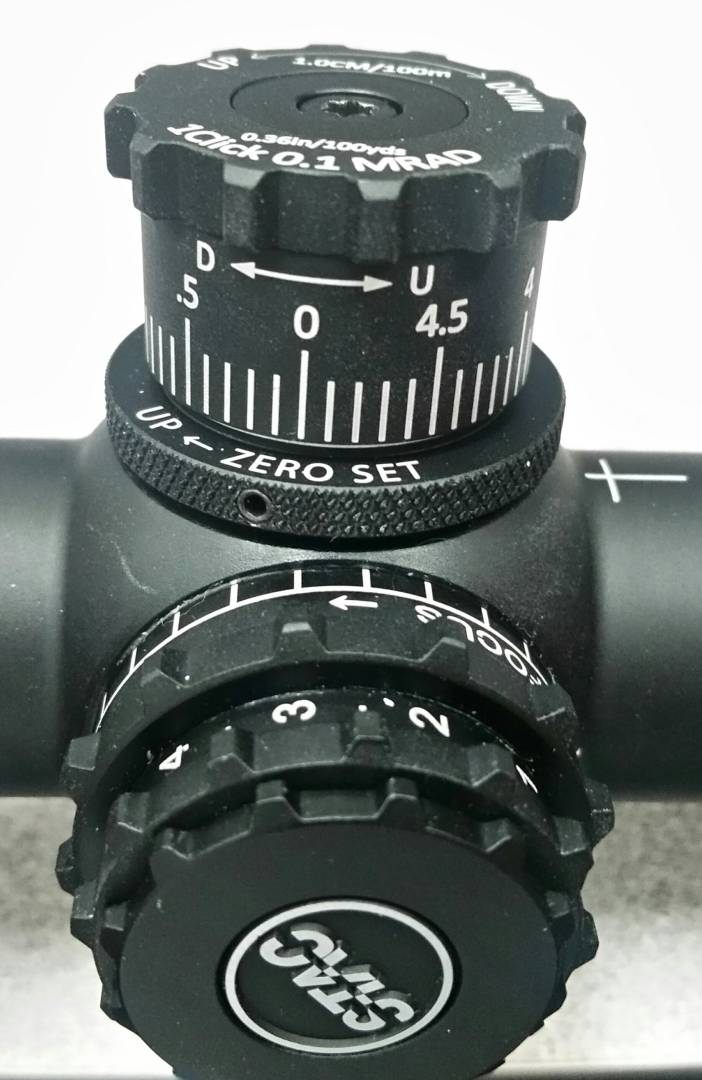
Sightron's new zero stop concept on an upcoming S-Tac mil/mil FFP scope Testing Methodology: Adjustments, Reticle Size, Reticle Cant When testing scope adjustments, I use the adjustable V-block on the right of the test rig to first center the erector. Approximately .2 or so mil of deviation is allowed from center in the erector as it is difficult to do better than this because the adjustable V-block has some play in it. The erector can be centered with the scope mounted or not mounted. If it started unmounted, I mount it after centering. I next set the zero stop (on scopes with such a feature) to this centered erector and attach the optic to the rail on the left side of the test rig. 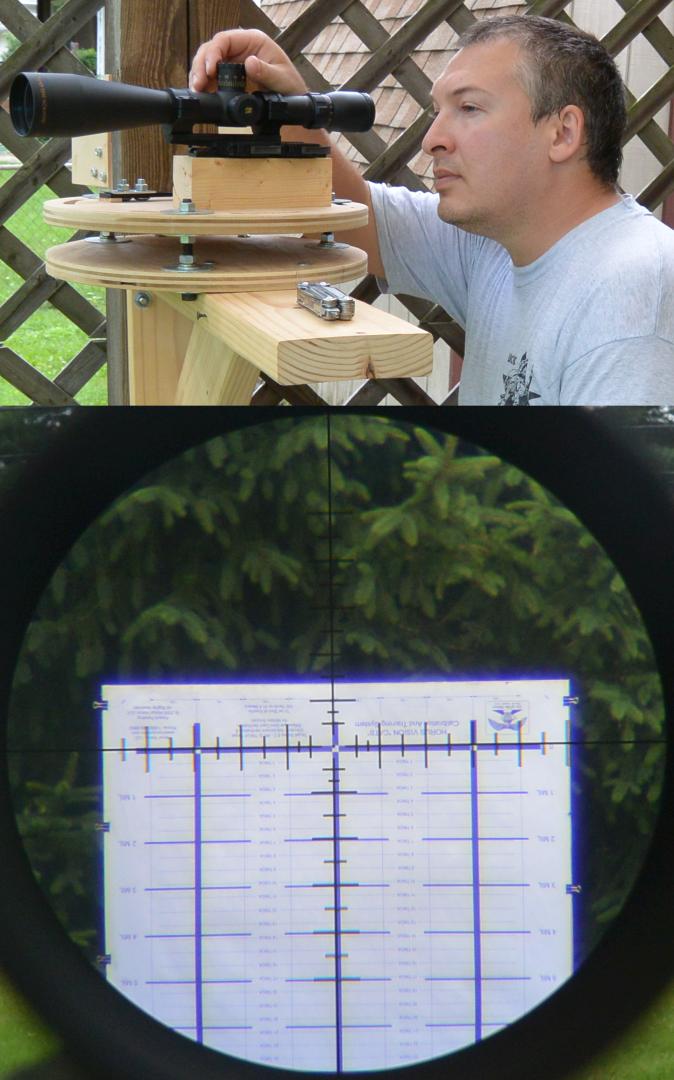
Mechanical testing apparatus and target The three fine threaded 7/16" bolts on the rig allow the scope to be aimed precisely at an 8'x3' Horus CATS 280F target 100 yds downrange as measured by a quality fiberglass tape measure. The target is also trued to vertical with a bubble level. The reticle is aimed such that its centerline is perfectly aligned with the centerline of the target and it is vertically centered on the 0 mil elevation line. The CATS target is graduated in both mils and true MOA and calibrated for 100 yards. The target is mounted upside-down on a target backer designed specifically for this purpose as the target was designed to be fired at rather than being used in conjunction with a stationary scope. (Since up for bullet impact means down for reticle movement on the target, the inversion is necessary.) With the three bolts tightened on the test rig head, the deflection of the rig is about .1 mil under the force required to move adjustments. The rig immediately returns to zero when the force is removed. It is a very solid, very precise test platform. These bolts allow the scope to be precisely positioned such that its reticle is perfectly aligned with the test target prior to moving the adjustments. Each click of movement in the scope adjustments moves the reticle on the target and this can observed by the tester as it actually happens during the test: it's quite a lot of fun if you are a bit of a nerd like I am! After properly setting the parallax to the target (head bob method) and diopter (after the parallax), I move the elevation adjustment though the range from erector center until it stops, making note every 5 mils of adjustment dialed of any deviation in the position of the reticle on the target relative to where it should be and also making note of the total travel and any excess travel in the elevation knob after the reticle stops moving but before the knob stops. At the extent of this travel I can also determine the cant of the reticle by measuring how far off of the target centerline the reticle has moved. I next reverse the adjustment process and go back down to zero. This is done several times to verify consistency with any notes taken of changes. After testing the elevation adjustments in this manner, the windage adjustments are tested out to 4 mils each way in similar fashion using the same target and basically the same method. The elevation and windage are then tested in conjunction with one another by making a large box 8 mil wide and as tall as the adjustments will allow. If the scope is one where it is easy to do so (not a pin type zero stop model), I next re-align the test rig to point the scope at the bottom of the target and test the elevation in the other direction for tracking and range. After concluding the testing of adjustments, I also test the reticle size calibration. This is done quite easily on this same target by comparing the reticle markings to those on the target. Testing a single scope of a given model from a given manufacturer, which is really all that is feasible, is not meant to be indicative of all scopes from that maker. Accuracy of adjustments, reticle size, and cant will differ from scope to scope. After testing a number of scopes, I have a few theories as to why. As designed on paper, I doubt that any decent scope has flaws resulting in inaccurate clicks in the center of the adjustment range. Similarly, I expect few scopes are designed with inaccurate reticle sizes (and I don't even know how you would go about designing a canted reticle as the reticle is etched on a round piece of glass and cant simply results from it being rotated incorrectly when positioned). However, ideal designs aside, during scope assembly the lenses are positioned by hand and will be off by this much or that much. This deviation in lens position from design spec can cause the reticle size or adjustment magnitude to be incorrect and, I believe, is the reason for these problems in most scopes. Every scope maker is going to have a maximum acceptable amount of deviation from spec that is acceptable to them and I very much doubt they would be willing to tell you what this number is, or better yet, what the standard of deviation is. The tighter the tolerance, the better from the standpoint of the buyer, but also the longer average time it will take to assemble a scope and, therefore, the higher the cost. Assembly time is a major cost in scope manufacture. It is actually the reason that those S&B 1-8x short dots took years to make it to market. Tolerances are a particular concern for scopes that have high magnification ratios and also for those that are short in length. Both of these design attributes tend to make assembly very touchy. This should make you, the buyer, particularly careful to test purchased scopes that have these desirable attributes, as manufacturers will face greater pressure on these types to allow looser standards. If you test your scope and find it lacking, I expect that you will not have too much difficulty in convincing a maker with a reputation for good customer service to remedy it: squeaky wheel gets the oil and all that. Remember that some deviations, say a scope’s adjustments being 1% too large or small, are easy to adjust for in ballistic software, whereas others, a large reticle cant for instance, are not. Before I leave adjustments, reticle size, and reticle cant, I will give you some general trends I have noticed so far. The average adjustment deviation seems to vary on many models with distance from optical center. This is a good endorsement for a 20 MOA base, as it will keep you closer to center for longer. The average deviation for a scope’s elevation seems to be about .1% at 10 mils. Reticle size deviation is sometimes found to vary with adjustments so that both the reticle and adjustments are off in the same way and with similar magnitude. This makes them agree with each other when it comes to follow up shots. I expect this is caused by the error in objective lens position affecting both the same. In scopes that have had a reticle with error, it has been of this variety, but fewer scopes have this issue than have adjustments that are off. Reticle size deviation does not appear to vary in magnitude as you move from erector center although adjustment deviation often does. The mean amount of reticle error is less than .05%. Reticle cant mean is about .05 degrees. Reticle cant, it should be noted, affects the shooter as a function of calculated drop and can easily get lost in the windage read. As an example, a 1 degree cant equates to about 21 cm at 1000 meters with a 168 gr .308 load that drops 12.1 mil at that distance. That is a lot of drop, and a windage misread of 1 mph is of substantially greater magnitude (more than 34 cm) than our example reticle cant-induced error. This type of calculation should be kept in mind when examining all mechanical and optical deviations in a given scope: a deviation is really only important if it is of a magnitude similar to the deviations expected to be introduced by they shooter, conditions, rifle, and ammunition. Lastly, the proliferation of "humbler" type testing units such as mine appears to have resulted in scope companies improving their QC standards. I see less deviation in products now then a few years ago. Testing Methodology: Comparative Optical Evaluation The goal of my optical performance evaluation is NOT to attempt to establish some sort of objective ranking system. There are a number of reasons for this. Firstly, it is notoriously difficult to measure optics in an objective and quantifiable way. Tools, such as MTF plots, have been devised for that purpose, primarily by the photography business. Use of such tools for measuring rifle scopes is complicated by the fact that scopes do not have any image recording function and therefore a camera must be used in conjunction with the scope. Those who have taken through-the-scope pictures will understand the image to image variance in quality and the ridiculousness of attempting to determine quality of the scope via images so obtained. Beyond the difficulty of applying objective and quantifiable tools from the photography industry to rifle scopes, additional difficulties are encountered in the duplication of repeatable and meaningful test conditions. Rifle scopes are designed to be used primarily outside, in natural lighting, and over substantial distances. Natural lighting conditions are not amenable to repeat performances. This is especially true if you live in central Ohio, as I do. Without repeatable conditions, analysis tools have no value, as the conditions are a primary factor in the performance of the optic. Lastly, the analysis of any data gathered, even if such meaningful data were gathered, would not be without additional difficulties. It is not immediately obvious which aspects of optical performance, such as resolution, color rendition, contrast, curvature of field, distortion, and chromatic aberration, should be considered of greater or lesser importance. For such analysis to have great value, not only would a ranking of optical aspects be in order, but a compelling and decisive formula would have to be devised to quantitatively weigh the relative merits of the different aspects. Suffice it to say, I have neither the desire nor the resources to embark on such a multi-million dollar project and, further, I expect it would be a failure anyway as, in the end no agreement will be reached on the relative weights of different factors in analysis. The goal of my optical performance evaluation is instead to help the reader get a sense of the personality of a particular optic. Much of the testing documents the particular impressions each optic makes on the tester. An example of this might be a scope with a particularly poor eyebox behind which the user notices he just can't seem to get to a point where the whole image is clear. Likewise, a scope might jump out to the tester as having a very bad chromatic aberration problem that makes it difficult to see things clearly as everything is fringed with odd colors. Often these personality quirks mean more to the users’ experience than any particular magnitude of resolution number would. My testing seeks to document the experience of using a particular scope in such a way that the reader will form an impression similar to that of the tester with regard to like or dislike and will be aware of the reasons for that impression. The central technique utilized for this testing is comparative observation. One of the test heads designed for my humbler apparatus consists of five V-blocks of which four are adjustable. This allows each of the four scopes on the adjustable blocks to be aimed such that they are collinear with the fifth. For the majority of the testing, each scope is then set to the same power (the highest power shared by all as a rule). Though power numbers are by no means accurately marked, an approximation will be obtained. Each scope will have the diopter individually adjusted by the tester, the adjustments centered optically, and the parallax set. A variety of targets, including both natural backdrops and optical test targets, will be observed through the plurality of optics with the parallax being adjusted for each optic at each target. A variety of lighting conditions over a variety of days will be utilized. Specific notes are made regarding: resolution, color rendition, contrast, field of view, edge to edge quality, light transmission, pincushion and barrel distortion, chromatic aberration, tunneling, depth of field, eyebox, stray light handling, and optical flare. The observations through all of these sessions will be combined in the way that the tester best believes conveys his opinion of the optic’s performance and explains the reasons why. 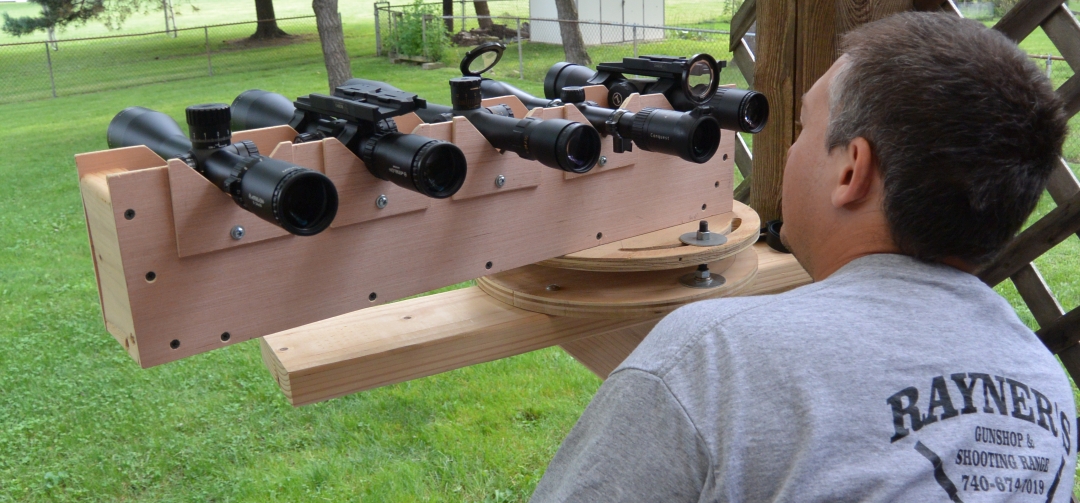
Comparative optical testing of this years sub $1k precision rifle scopes behind the adjustable v-block |
|
|
|
|
As always excellent review. I am disappointed that there was so much deviation. Always heard great things about how great they tracked. Thank you for taking the time to post.
|
|
|
|
|
I f*ckin hate leftists.... seriously, I do.
|
Outstanding work, it is appreciated.
|
|
"They who can give up essential liberty to obtain a little temporary safety, deserve neither liberty nor safety."
Ben Franklin |
|
Since you say CA was average in this field, I'm assuming the massive amount of purple fringing shown in those pictures isn't representative of the view in person. Would you say that is correct?
|
|
|
|
|
Originally Posted By Vapor_Man:
Since you say CA was average in this field, I'm assuming the massive amount of purple fringing shown in those pictures isn't representative of the view in person. Would you say that is correct? View Quote |
|
|
|
 Win a FREE Membership!
Win a FREE Membership!
Sign up for the ARFCOM weekly newsletter and be entered to win a free ARFCOM membership. One new winner* is announced every week!
You will receive an email every Friday morning featuring the latest chatter from the hottest topics, breaking news surrounding legislation, as well as exclusive deals only available to ARFCOM email subscribers.
AR15.COM is the world's largest firearm community and is a gathering place for firearm enthusiasts of all types.
From hunters and military members, to competition shooters and general firearm enthusiasts, we welcome anyone who values and respects the way of the firearm.
Subscribe to our monthly Newsletter to receive firearm news, product discounts from your favorite Industry Partners, and more.
Copyright © 1996-2024 AR15.COM LLC. All Rights Reserved.
Any use of this content without express written consent is prohibited.
AR15.Com reserves the right to overwrite or replace any affiliate, commercial, or monetizable links, posted by users, with our own.

